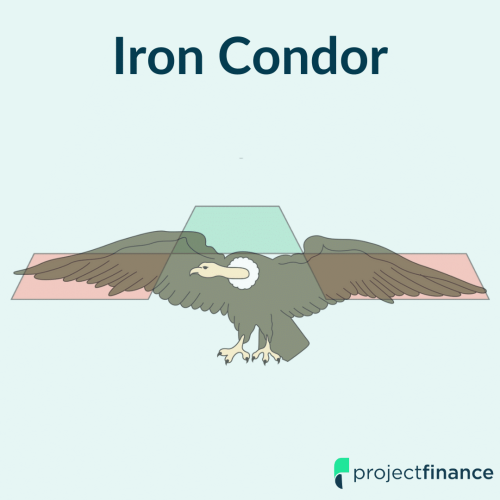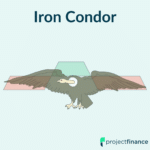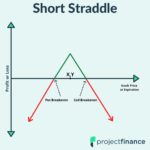Last updated on February 10th, 2022 , 01:07 pm

What is the Iron Condor Options Strategy?
The Iron Condor consists of the combination of two popular vertical spread strategies: the bull put spread and bear call spread. Specifically, this is the setup for selling an iron condor, which is the most popular way to trade the strategy.
Jump To
Combining a bull put spread and a bear call spread results in a market-neutral position that profits when the stock price remains in-between the two spreads:
The above chart shows the expiration payoff for a hypothetical short Iron Condor position constructed with the following vertical spreads in the same expiration cycle:
Bull Put Spread
– Sell the 450 put for $10.00
– Buy the 400 put for $2.50
Bear Call Spread
– Sell the 550 call for $10.00
– Buy the 600 call for $2.50
Since $20.00 is collected for selling the 450 put and 550 call, and $5.00 is paid for purchasing the 400 put and 600 call, this Iron Condor example trade is said to be entered for a $15.00 net credit.

New to options trading? Learn the essential concepts of options trading with our FREE 160+ page Options Trading for Beginners PDF.
Maximum Profit Potential of an Iron Condor
Maximum Profit Potential: Net Credit x 100
The maximum profit potential of one short Iron Condor is the net credit received, times 100, as standard equity options have a contract multiplier of 100 (such as options on AAPL, MSFT, SPY).
In the above example trade, the net credit is $15.00, which results in a maximum profit potential of $1,500 per Iron Condor sold:
$15.00 Net Credit x 100 = $1,500 Max Profit Potential.
The maximum profit potential is realized when the stock price is in-between the short put strike price and short call strike price at expiration. In this example, that’s anywhere between $450 and $550:
Maximum Loss Potential of an Iron Condor
Maximum Loss Potential: (Width of Widest Spread – Net Credit) x 100
The maximum loss potential of selling one Iron Condor position is the strike price width of the wider vertical spread, less the net credit, times 100:
$50.00 Max Spread Width – $15.00 Net Credit x 100 = $3,500 Max Loss Potential.
Since only one of the spreads can be fully in-the-money at expiration, the width of the wider spread is the maximum value of the Iron Condor at expiration. In this example, both the call spread and put spread are $50 wide (400/450 put spread and 550/600 call spread).
If the Iron Condor is sold for $15.00, an increase to its maximum value of $50.00 would represent a loss of $3,500: ($15.00 Sale Price – $50.00 Maximum Trade Value) x 100 = -$3,500.
The maximum loss potential occurs if the stock price is entirely below the put spread OR entirely above the call spread at expiration:
Probability of Making Money
While it may seem illogical to enter a trade with $1,500 in profit potential and $3,500 in loss potential, keep in mind that the stock price can increase or decrease up to 10% and the Iron Condor will realize the full $1,500 profit.
The only way the $3,500 max loss potential is realized is if the stock price is below $400 (the long put’s strike price) or above $600 (the long call’s strike price) at expiration. In other words, the stock price must increase/decrease by more than 20%.
Since the $1,500 profit is realized as long as the stock price remains within 10% of the $500 stock price at the time of entry, selling Iron Condors is a high probability trading strategy, meaning the probability of profiting on the trade is greater than 50%, in theory.
Benefits of the Short Iron Condor Strategy
Selling Iron Condors is an extremely popular options trading approach for good reason. Here are the biggest benefits that make the strategy a crowd favorite:
✓ Limited-Risk Strategy – The loss potential is known before putting the trade on. No surprises.
✓ High Probability of Profit – The short Iron Condor makes the full profit when the stock price is in-between the two spreads at expiration, which means the stock price can be anywhere within the two spreads and the strategy will make money.
✓ Market-Neutral Strategy – Most trading strategies have a directional bias, meaning the stock price must move in a specific direction for the trade to profit. The short Iron Condor has no directional bias, as the trader just needs the stock price to remain within a certain range over time.
Risks of the Short Iron Condor Strategy
All strategies have risks. Here are the primary risks present when selling Iron Condors:
✓ More Risk Than Reward (Most Cases) – The high loss potential relative to the potential reward can be jarring for some, especially very risk-averse traders. However, it’s important to remember that the risk/reward relationship is a function of the strategy’s high probability of profit.
✓ Can Lose Money During Strong Bull Markets – Since selling Iron Condors is a market-neutral strategy, the trade loses money if the stock price increases significantly in a short period. During strong bull market periods, the short Iron Condor strategy will likely struggle to profit, which may deter traders who want bullish exposure to the stock market long-term.
✓ Early Assignment Risk – If the stock price falls well below the short put’s strike price or rises well above the short call’s strike price, the trader may be assigned on the short option that is in-the-money. While getting assigned doesn’t change the risk of the position or cause a large loss, it does turn the trade into a messy combination of options and shares of stock, which is an undesirable outcome for most.
The Impact of Time Decay
If the stock price is in-between the two spreads, the options will all consist of 100% extrinsic value, which is lost over time as the options approach expiration.
If the stock price is fully beyond one of the spreads, the Iron Condor’s value will steadily appreciate to the value of the spread width as time passes. For instance, if the stock price is at $150 and a trader has an Iron Condor with the 140/145 short call spread ($5 spread width), the Iron Condor’s value will steadily appreciate to $5.00 as expiration approaches.
The Impact of Falling Implied Volatility
Implied volatility measures the amount of extrinsic value that exist in a stock’s options relative to the time until those options expire.
As an Iron Condor seller, the best-case scenario is that the options lose value over time and expire worthless.
Because of that, a decrease in implied volatility (a decrease in extrinsic value in the options) is beneficial to Iron Condor sellers, as a decrease in implied volatility indicates that the stock’s options have gotten cheaper through a decrease in extrinsic value.
A decrease in extrinsic value just means the market is expecting less volatility from the stock in the future, which results in less demand for the options and therefore a drop in the amount of extrinsic value the options have.
The Impact of Rising Implied Volatility
Conversely, an increase in implied volatility (an increase in extrinsic value in the options) is harmful to Iron Condor sellers, as an increase in implied volatility indicates that the stock’s options have gotten more expensive through an increase in extrinsic value.
An increase in extrinsic value just means the market is expecting more volatility from the stock in the future, which results in more demand for the options and therefore an increase in the amount of extrinsic value the options have.
projectfinance Options Tutorials

About the Author
Chris Butler received his Bachelor’s degree in Finance from DePaul University and has nine years of experience in the financial markets.
Chris started the projectfinance YouTube channel in 2016, which has accumulated over 25 million views from investors globally.


